One of my favorite things to do is play board games. While you can play them online, I love the social aspect of playing them in person, the tactical feel of moving around pieces, and the look of a great game sitting on a table. It probably won’t be much of a surprise to tell you I didn’t get to play many board games last year. While this isn’t a big loss compared to the toll the pandemic has taken on many other people, I still miss playing them and miss the time spent with other people. Since we can’t sit around a table together enjoying a game right now, I’d like to tell you about my favorite games and what makes them great. I hope you enjoy hearing my 25 picks for the best board games out there and look forward to the day we might even get to play them together!
Here are numbers 21-25. Check back in for more posts; we’ll work our way up to number 1.
 |
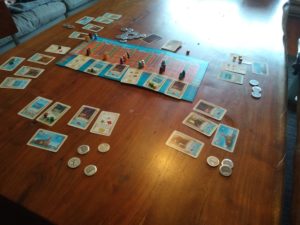 |
25) The Speicherstadt (2010): Lots of games challenge you by providing you limited resources, but this game takes that to the next level by providing you with one piddly coin every turn. While the cards you buy are simple, the auction mechanic forces you to make agonizing choices. Even though the theme of the game is about managing a business, every turn feels like a battle as you deploy your three bids in order to both drive up the prices and get a shot at the card you need. You never want to pass on a card and give your opponent a bargain, but overpaying will leave you short of cash at a crucial moment, stopping you from getting a vital card. Never too long for its depth, this game is good with four, but fantastic with five players and one of the prime choices for that player count.
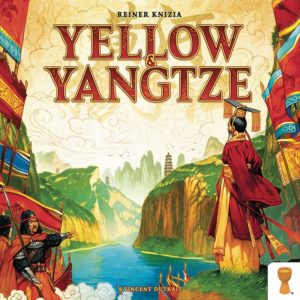 |
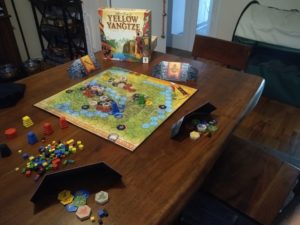 |
24) Yellow and Yangtze (2018): When Tigris and Euphrates was released in 1997 no other game was like it. Quickly it was hailed as one of the best designs ever, an opinion many people hold to this day. The reasons for this are very clear. The gameplay is wonderfully strategic, the board development has a huge variety between games, it features a nice pace of steady progression interspersed with rapid action, and it usually ends with a giant decisive conflict. Truth be told, though, it wasn’t one of my favorites. It has a number of issues that bug me. So when Yellow and Yangtze came out, a new game that was clearly the spiritual successor to Tigris and Euphrates, I wasn’t excited, but, after playing it, I was floored. Everything about Tigris and Euphrates that I didn’t like was addressed in this game! The map switched from squares to hexes, opening up board growth choices. The monuments, previously a giant liability, were now central to gameplay, driving constant interactions. The giant wars were still potentially decisive, but now were less swingy and potentially recoverable, no longer making them the entire goal of the game, keeping all of the other wonderful parts vital to winning. Every color was given its own useful property, allowing creative players to thrive even when their tile draws seem suspect. Yellow and Yangtze is a wonderful game experience and seeing how one of the greatest game designers ever thoughtfully reinvented one of his best games with 20 years of hindsight is a beautiful thing.
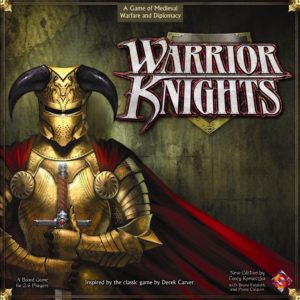 |
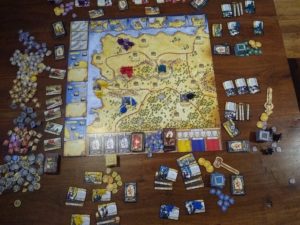 |
23) Warrior Knights (1985): Have you ever heard the expression that something might be “greater than the sum of its parts?” Warrior Knights is a game from the 80’s, a time before many of the modern developments in game design that makes today’s games so fun. But there are still some extremely good games from this era, and Warrior Knights is one of them. It’s an ambitious game with four different major subsystems all going on at the same time. That’s complicated, but fortunately each mechanism is creative and engaging. The counsel lets you test your political instincts, the spice trade introduces risk management, the map play is distinctly spatial, the combat is strategic, and the economics force difficult decisions on a player’s priorities. Maintaining control over all of these moving parts requires constant attention. The way actions in this game are both completely in control of the players but also happen in a random order makes the game feels frantic even though the pace is actually quite plodding. Unfortunately, the way the many elements of the game fit together is a bit clunky, so much to the point where it is difficult to actually form a coherent vision of how to play the game. The grand design is a little bit less than the sum of its parts, but by sacrificing a little bit of the elegance of modern design, Warrior Knights gives you an unprecedented variety of experience and drama that is an absolute blast to play.
 |
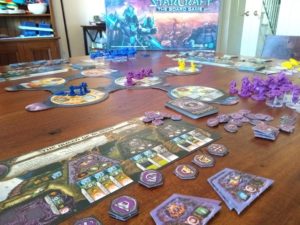 |
22) Starcraft (2007): Turning one of the most beloved video games in history into a board game should have been a train wreck. What works well for one medium doesn’t necessarily translate to another. There’s no way that they could be true to such a complex game, with all of the units, the tech trees, the strategies, and the feel that makes Starcraft special. But in this game, they came really close. While not particularly great as a free-for-all, when played 2v2 or 3v3, Starcraft is a blast. The three different armies are completely unique and the upgrades let you customize your forces in a myriad of ways. The mechanics favor aggression and the card driven resolution gives players a lot of interesting decisions and strategic control, while also including the uncertainty you need in this type of game. The order system doesn’t feel anything like the video game, but it keeps turns moving in a frantic, unpredictable manner. And for the fans of Starcraft, all of the buildings and units are true to the video game to a degree that shows the designers clearly had a love for the source material. Unfortunately, there is some sloppiness in the rules which are addressed in an expansion, but that expansion in turn also adds a ton of additional stuff that makes this into a real monster of a game that is extremely daunting to try to teach. But those issues are excusable considering how great the good parts of this game are. Some people are going to think all of the bells and whistles are silly for what is, at its heart, a territory control game, but those bells and whistles bring this game over the top to be the one of the best board games ever.
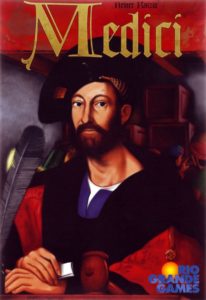 |
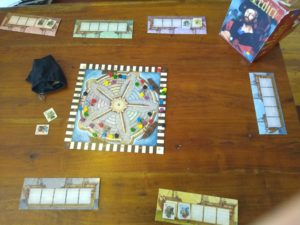 |
21) Medici (1995): Strategy games can be simple. While games with tons of bells and whistles are often fun, you don’t need them. At its core, all you need to do is have a straightforward goal with meaningful decisions where skill is needed to understand the consequences of each choice. Combine that with limitations that constrain the players and a force that moves the action towards a conclusion and you’ve got the recipe for a great game. That’s exactly what you get with Medici and not a thing more. With a mere 5 spaces on your boat to fill, you can’t do much each round, but every choice you make is vital. Every turn you will have to decide if the pieces being offered are worth buying and at what price. Obviously everyone wants the good pieces, but good is relative. Can you diverge your incentives from the other players, and will you be able to profit from that divergence? The difficult mechanic here is that pieces can be auctioned off by themselves or in bundles where the pieces might be packaged in awkward combinations that are difficult to evaluate. It’s a lot of head scratching, but it plays quickly. Plus, if you finish your ship early you can walk away from the table and get a drink, which is one one of the most underrated qualities around in board games.
